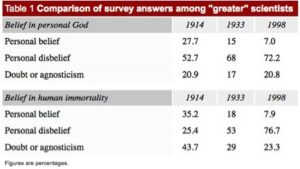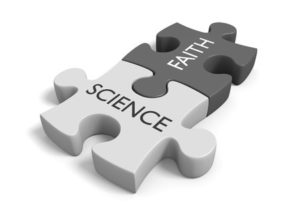Scientist, What Do You Believe?
In 1997, Edward Larson and Larry Witham sought to replicate a famous early 20th century survey by James Leuba on what typical scientists affirmed regarding two central beliefs of Christianity. These two dogmas were belief in a personal God, and belief in human immortality. Leuba found that 58.2% of US scientists expressed disbelief or doubt in the existence of God. Roughly 50% believed in human immortality. Larson and Witham’s replication eighty years later found little change among American scientists: 59.8% expressed doubt or disbelief in a personal God; 61.9% doubted or disbelieved in human immortality.
|
Comparison among “regular” scientists |
||
|
1916 |
1996 |
|
|
Belief in a personal God |
||
|
Personal belief |
41.8% |
39.3% |
|
Personal disbelief |
41.5% |
45.3% |
|
Doubt or agnosticism |
16.7% |
14.5% |
|
Belief in human immortality |
||
|
Personal belief |
50.6% |
38.0% |
|
Personal disbelief |
about 20% |
46.9% |
|
Doubt or agnosticism |
about 30% |
15.0% |
Larson and Witham noted that Leuba’s finding of widespread disbelief among US scientists 100 years ago was shocking at that time. It became a central element in the anti-modernism speeches given by William Jennings Bryan and others. Yet the similarity to their 1996 findings among “regular” scientists is equally shocking. “Today, many people presume that scientists are far less likely to believe in the supernatural than the general population.”
Despite the stability in the overall proportion of believers and disbelievers, there has been a significant shift in views held by the three professions surveyed—mathematics, biology and physics/astronomy. The 1996 survey showed that mathematicians are most inclined to believe in God (44.6%). And although biologists showed the highest rates of disbelief or doubt in Leuba’s day (69.5%), that ranking is now given to physicists and astronomers (77.9%).
The interesting twist was when Larson and Witham repeated Leuba’s survey of leading or elite scientists. Within the circle of elite scientists, Leuba saw doubt or disbelief in God rise to 73.6%. Larson and Witham found disbelief or doubt in God among elite scientists to be 93%. Only 7.0% of modern elite US scientists affirmed a belief in God, while 27.7% did so in 1914. The following table compares the findings of Larson and Witham to Leuba among so-called “elite” scientists.
 Leuba thought his findings demanded a revision of public opinion on the prevalence and future of these two “cardinal beliefs.” He said: “The essential problem facing organized Christianity is constituted by the wide-spread rejection of its two fundamental dogmas.” Leuba saw this rejection as growing parallel to—and not caused by—the diffusion of knowledge and intellectual qualities that come with eminence in scholarly pursuits.
Leuba thought his findings demanded a revision of public opinion on the prevalence and future of these two “cardinal beliefs.” He said: “The essential problem facing organized Christianity is constituted by the wide-spread rejection of its two fundamental dogmas.” Leuba saw this rejection as growing parallel to—and not caused by—the diffusion of knowledge and intellectual qualities that come with eminence in scholarly pursuits.
I conclude, therefore, that the greater loss of belief suffered by the greater men is probably not to be ascribed to their greater knowledge, but rather to certain temperamental qualities or energies which make it relatively easy for them to rid themselves of much of the social pressure to which others yield.
According to Leuba, the elite scientist existed in a social environment where “intellectual freedom is honored far above orthodoxy.” This removed him from the “lower circles where tradition holds undisputed sway.” Therefore they were relieved of the pressures, which bear upon their less favored colleagues. If they were from eminent families, then they were doubly favored because from an early age they have been freer than lesser men from influence of “narrow traditional opinion” upon youth. See a copy of Leuba’s original 1916 work, The Belief in God and Immortality, here.
Larson and Witham pointed out that given the ongoing persistence of the belief in God (about 90% of Americans believe in God), Leuba seems to have either misjudged the human mind or the ability of science to satisfy all human needs. Nevertheless, their own study indicated: “among the top natural scientists, disbelief is greater than ever — almost total.”
Leuba wrongly assumed that the rationalism and secularity of science would eventually overtake and replace the truth claims of religion within American culture. Ecklund and Scheitle noted how Leuba concluded from his research that in order for religion to continue to have an influence on American society, it should capitulate to science. They quoted the following from a 1934 article by Leuba:
In order to be again a vitalizing and controlling power in society, the religions will have to organize themselves about ultimate conceptions that are not in contradiction with the insight of the time. They will have to replace their specific method of seeking the welfare of humanity to appeal to, and reliance upon divine Beings, by methods free from a discredited supernaturalism.
While American society did not fall victim to Leuba’s prediction of a widespread decline in traditional forms of religiosity, his finding about the differences between scientists and the general population was supported. This corroborated the perception of a conflict between the principles of religion and those of science. It also seemed to confirm that individuals who pursued science tended to abandon religion—whether that abandonment was due to an inherent conflict between the knowledge claims of religion and science or because of the secularization of scientific education.
In 2007 Ecklund and Scheitle examined the religiosity of faculty members from randomly selected institutions in the University of Florida’s annual report, “Top American Research Universities.” Respondents were asked about their religious identity, beliefs and practices. This included questions about their view of God, religion and church attendance. A comparison of current religious affiliation and affiliation as a child was done between the responding scientists and the U.S. population. The following is an edited discussion of their findings. See the above link for a fuller discussion.
While nearly 14 percent of the U.S. population self-describe as “evangelicals” or “fundamentalists,” only 1.5% of the scientists from elite universities did. Almost 52% of the scientists said they had not current religious affiliation, compared to 14.2% of the general population. Ecklund and Scheitle’s findings did not report data on evangelical/fundamentalist affiliation as a child. However, there were noticeable differences in the religious affiliation of scientists now and when they were children. Scientists who affiliated as Protestant and Catholic as children decreased significantly as they grew older and were educated. See the chart below.
|
Scientists |
U.S. Population |
|
|
Current affiliation |
||
|
Evangelical/fundamentalist |
1.5 |
13.6 |
|
Other Protestant |
15.2 |
40.8 |
|
Catholic |
8.7 |
18.3 |
|
Jewish |
15.3 |
1.8 |
|
Other |
7.3 |
4.5 |
|
None |
51.8 |
14.2 |
|
Affiliation as a child |
||
|
Protestant |
39.0 |
54 |
|
Catholic |
22.6 |
31 |
|
Jewish |
18.5 |
2.2 |
|
Other |
6.5 |
4.6 |
|
None |
13.4 |
8.3 |
Ecklund and Scheitle did find that academics at elite research universities were less religious than the public. But assuming that becoming a scientist necessarily leads to losing religious commitments was untenable. “Our results indicate that people from certain backgrounds (the non-religious, for example) disproportionately self-select into scientific professions.” However, being raised in a home where religion was very important meant it was more likely that “a scientist would remain relatively more religious.” Scientists who said religion was important in their family when growing up were more likely to see truth in religion, to believe in God, and to attend religious services.
Finding that the strongest predictor of religious adherence among this group was childhood religiosity recasts previous theories about lack of religiosity among academic scientists in a new light. The idea that scientists simply drop their religious identities upon professional training, whether due to an inherent conflict between science and faith or institutional pressure, is not strongly supported by these data. If this was the case, then religious upbringing would have little effect on religion among scientists, with even those scientists who were raised in religious homes losing religion once they entered the academy or received scientific training. Instead … religious socialization and heritage remains the strongest predictor of present religiosity among this population of scientists.
So the assumed power of scientific rationalism and secularity has not been able to overtake and replace the religiosity of the general American population, as Leuba predicted. And although elite American scientists are less religious than the general public, it seems that demographic factors such as age, marital status and children in the home are stronger predictors of religiosity than their scientific training. “In particular, religiosity in the home as a child is the most important predictor of present religiosity.”
But I would think that it is the rich, fully embraced religiosity practiced in a home that has staying power as the child grows into adulthood. A shallow, conduct-oriented religiosity will fall away. When religion is a do-and-don’t-do system of regulation, it tends to fall away. But if a child is trained in a way that enables him to see and internalize the heart of his childhood religion, then when he grows old, he will not turn from it (Proverbs 22:6). Even if he is an elite scientist.

